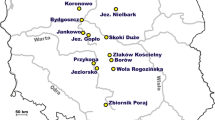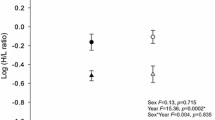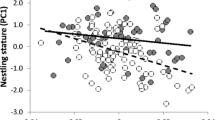Abstract
According to the viability indicator hypothesis, ornaments of many bird species honestly signal individual quality and health status. In this study, we investigated the health- and stress-indicating capacity of both feather- and skin-based ornamental traits in the grey partridge (Perdix perdix), a vulnerable avian species of the European agricultural landscape. In 50 free-living males, we assessed individual health status by examining the differential and absolute leukocyte counts, absolute erythrocyte count, complement activity, and pro-inflammatory immune responsiveness to phytohaemagglutinin (PHA). We found that males expressing extensive melanin-pigmented breast ornaments developed stronger skin inflammation after PHA stimulation than males with limited ornaments, suggesting that these are high-quality individuals that are able to mount a robust immune response. Furthermore, we found that the UV signal of the carotenoid-pigmented eye patch ornament is negatively related to the absolute immature erythrocyte count and the peripheral blood heterophil/lymphocyte (H/L) ratio, indicating that males with a slow pace of life and healthier males express skin ornaments with higher UV reflectance. Ornamental colouration in grey partridge males may, therefore, serve as a reliable signal of condition (in terms of resource balance) and health (in terms of stress resistance) to females.
Zusammenfassung
Melanin- und karotinoidbasierte Ornamentation hängt bei freilebenden Rebhühnern ( Perdix perdix ) von der individuellen Körperkondition ab.
Gemäß der Handicap-Hypothese dienen die Ornamente vieler Vogelarten als ehrliches Signal für individuelle Qualität und Gesundheitszustand. In dieser Studie untersuchten wir die gesundheits- und stressanzeigende Funktion von ornamentalen Merkmalen sowohl des Gefieders als auch der Hautpartien bei Rebhühnern (Perdix perdix), einer gefährdeten Vogelart europäischer Agrarlandschaften. Wir bewerteten den individuellen Gesundheitszustand von 50 freilebenden Männchen, indem wir die differenziellen und absoluten Leukozytenzahlen, die absoluten Erythrozytenzahlen, die Aktivität des Komplementsystems und die proinflammatorische Immunantwort auf Phytohämagglutinin (PHA) betrachteten. Wir stellten fest, dass Männchen, welche ausgedehnte melaninpigmentierte Brustornamente trugen, nach PHA-Stimulation eine stärkere entzündliche Hautreaktion zeigten, als Männchen mit begrenzten Ornamenten, was nahelegt, dass es sich hier um Individuen hoher Qualität handelt, die eine starke Immunantwort aktivieren können. Weiterhin fanden wir heraus, dass das UV-Signal des durch Karotinoidpigmente gefärbten Augenflecks in negativem Verhältnis zur absoluten Anzahl unreifer Erythrozyten und dem peripheren H/L-Verhältnis (Heterophile Granulozyten/Lymphozyten) steht, was andeutet, dass Männchen mit ruhigem Lebenswandel und besserer Gesundheit Hautornamente mit höherer UV-Reflexion ausbilden. Die Schmuckfärbung männlicher Rebhühner kann daher den Weibchen als zuverlässiges Signal für Körperkondition (im Hinblick auf die Ressourcenbilanz) und Gesundheit (bezüglich der Stressresistenz) dienen.


Similar content being viewed by others
References
Adelman JS, Ardia DR, Schat KA (2014) Ecoimmunology. In: Schat KA, Kaspers B, Kaiser P (eds) Avian immunology. Academic Press, San Diego, pp 391–411
Andersen LW, Kahlert J (2012) Genetic indications of translocated and stocked grey partridges (Perdix perdix): does the indigenous Danish grey partridge still exist? Biol J Lin Soc 105:694–710
Andersson M (1994) Sexual selection. Princeton Univ Press, Princeton
Ashley NT, Weil ZM, Nelson RJ (2012) Inflammation: mechanisms, costs, and natural variation. Annu Rev Ecol Evol Syst 43:385–406
Atosuo J, Lehtinen J, Vojtek L, Lilius EM (2013) Escherichia coli K-12 (pEGFPluxABCDEamp): a tool for analysis of bacterial killing by antibacterial agents and human complement activities on a real-time basis. Luminescence 28:771–779
Badyaev AV, Young RL (2004) Complexity and integration in sexual ornamentation: an example with carotenoid and melanin plumage pigmentation. J Evol Biol 17:1317–1327
Badyev AV, Hill GE (2000) Evolution of sexual dichromatism: contribution of carotenoid-versus melanin-based coloration. Biol J Lin Soc 69:153–172
Beani L, Dessi-Fulgheri F (1995) Mate choice in grey partridge, Perdix perdix: role of physical and behavioural male traits. Anim Behav 49:347–356
Belskii EA, Lugas’kova NV, Karfidova AA (2005) Reproductive parameters of adult birds and morphophysiological characteristics of chicks in the pied flycatcher (Ficedula hypoleuca Pall.) in technogenically polluted habitats. Russ J Ecol 36:329–335
Bílková B, Vinklerová J, Vinkler M (2015) The relationship between health and cell-mediated immunity measured in ecology: phytohaemagglutinin skin-swelling test mirrors blood cellular composition. J Exp Zool Part A 323:767–777
Buchanan KL, Evans MR, Goldsmith AR (2003) Testosterone, dominance signalling and immunosuppression in the house sparrow, Passer domesticus. Behav Ecol Sociobiol 55:50–59
Buner FD, Browne SJ, Aebischer NJ (2011) Experimental assessment of release methods for the re-establishment of a red-listed galliform, the grey partridge (Perdix perdix). Biol Conserv 144:593–601
Campbell TW, Ellis CK (2007) Avian and exotic animal hematology and cytology. Blackwell Publishing Professional, Ames
Carleton RE (2008) Ectoparasites affect hemoglobin and percentages of immature erythrocytes but not hematocrit in nestling Eastern Bluebirds. Wilson J Ornithol 120:565–568
Crawley MJ (2002) Statistical computing. Wiley, Chichester
Cucco M, Malacarne G, Ottonelli R, Patrone M (2006) Repeatability of cell-mediated and innate immunity, and other fitness-related traits, in the grey partridge. Can J Zool 84:72–79
Davis AK, Maney DL, Maerz JC (2008) The use of leukocyte profiles to measure stress in vertebrates: a review for ecologists. Funct Ecol 22:760–772
Doucet SM, Montgomerie R (2003) Structural plumage colour and parasites in satin bower birds Ptilonorhynchus violaceus: implications for sexual selection. J Avian Biol 34:237–242
Ducrest A, Keller L, Roulin A (2008) Pleiotropy in the melanocortin system, coloration and behavioural syndromes. Trends Ecol Evol 9:502–510
Dunn PO, Garvin JC, Whittingham LA, Freeman-Gallant CR, Hasselquist D (2010) Carotenoid and melanin-based ornaments signal similar aspects of male quality in two populations of the common yellowthroat. Funct Ecol 24:49–158
Egeland ES, Parker H, Liaaen-Jensen S (1993) Carotenoids in combs of capercaillie (Tetrao urogallus) fed defined diets. Poult Sci 72:747–751
Fitze PS, Richner H (2002) Differential effects of a parasite on ornamental structures based on melanins and carotenoids. Behav Ecol 13:401–407
Galván I, Alonso-Alvarez C (2008) An intracellular antioxidant determines the expression of a melanin-based signal in a bird. PLoS One 3:1–7
Gangoso L, Grande JM, Ducrest A-L, Figuerola J, Bortolotti GR, Andre´S JA, Roulin A (2011) MC1R-dependent, melanin-based colour polymorphism is associated with cell-mediated response in the Eleonora’s falcon. J Evol Biol 24:2055–2063
Garvin MC, Homer BL, Greiner EC (2003) Pathogenicity of Haemoproteus danilewskyi, Kruse, 1890, in blue jays (Cyanocitta cristata). J Wildl Dis 39:161–169
Gladbach A, Gladbach D, Quillefeldt P (2011) Male achromatic wing colouration is related to body condition and female reproductive investment in a dichromatic species, the upland goose. J Ethol 29:243–249
Griffith SC, Parker TH, Olson VA (2006) Melanin-versus carotenoid-based sexual signals: is the differences really so black and red? Anim Behav 71:749–763
Griggio M, Zanollo V, Herbert H (2010) UV plumage color is an honest signal of quality in male budgerigars. Ecol Res 25:77–82
Guindre-Parker S, Love OP (2014) Revisiting the condition-dependence of melanin-based plumage. J Avian Biol 45:29–33
Henderson LJ, Heidinger BJ, Evans NP, Arnold KE (2013) Ultraviolet crown coloration in female blue tits predicts reproductive success and baseline corticosterone. Behav Ecol 24:1299–1305
Hill GE (1990) Female house finches prefer colourful males: sexual selection for condition-dependent trait. Anim Behav 40:563–572
Hõrak P, Ots I, Tegelmann L, Møller AP (2000) Health impact of phytohaemagglutinin-induced immune challenge on great tit (Parus major) nestlings. Can J Zool 78:905–910
Hõrak P, Saks L, Karu U, Ots I, Surai PF, McGraw KJ (2004) How coccidian parasites affect health and appearance of greenfinches. J Anim Ecol 73:935–947
Jacquin L, Lenouvel P, Haussy C, Ducatez S, Gasparini J (2011) Melanin-based coloration is related to parasite intensity and cellular immune response in an urban free living bird: the feral pigeon Columba livia. J Avian Biol 42:11–15
Kennedy MW, Nager RG (2006) The perils and prospects of using phytohaemagglutinin in evolutionary ecology. Trends Ecol Evol 21:653–655
Kuijper DPJ, Oosterveld E, Wymenga E (2009) Decline and potential recovery of the European grey partridge (Perdix perdix) population—a review. Eur J Wildl Res 55:455–463
Lessels CN, Boag PT (1987) Unrepeatable repeatabilities: a common mistake. Auk 104:116–121
Liukkonen T (2006) Finnish native grey partridge (Perdix perdix) population differs clearly in mitochondrial DNA from the farm stock used for releases. Ann Zool Fenn 43:271–279
Lobato E, Moreno J, Merino S, Sanz JJ, Arriero E (2005) Haematological variables are good predictors of recruitment in nestling pied flycatchers (Ficedula hypoleuca). Ecoscience 12:27–34
Martin LB, Scheuerlein A, Wikelski M (2003) Immune activity elevates energy expenditure of house sparrows: a link between direct and indirect costs? Proc R Soc Lond 270:153–158
McGraw KJ (2006a) Mechanics of carotenoid-based coloration. In: Hill GE, MacGraw KJ (eds) Bird coloration. Mechanisms and measurements, vol I. Harvard Univ Press, Cambridge, pp 177–242
McGraw KJ (2006b) Mechanics of melanin-based coloration. In: Hill GE, MacGraw KJ (eds) Bird coloration. Mechanisms and measurements, vol I. Harvard Univ Press, Cambridge, pp 243–294
McGraw KJ, Hill GE (2000) Differential effects of endoparasitism on the expression of carotenoid- and melanin-based ornamental coloration. Proc R Soc Lond 267:1525–1531
Moreno-Rueda G (2010) Experimental test of a trade-off between moult and immune response in house sparrows Passer domesticus. J Evol Biol 23(10):2229–2237
Mougeot F, Redpath SM (2004) Sexual ornamentation relates to immune function in male red grouse Lagopus lagopus scoticus. J Avian Biol 35:425–433
Mougeot F, Redpath SM, Leckie F (2005) Ultra-violet reflectance of male and female red grouse, Lagopus lagopus scoticus: sexual ornaments reflect nematode parasite intensity. J Avian Biol 36:203–209
Mougeot F, Martínez-Padilla J, Pérez-Rodríguez L, Bortolotti GR (2007) Carotenoid-based colouration and ultraviolet reflectance of the sexual ornaments of grouse. Behav Ecol Sociobiol 61:741–751
Mougeot F, Martínez-Padilla J, Blount JD, Pérez-Rodríguez L, Webster LMI, Piertney SB (2010) Oxidative stress and the effect of parasites on a carotenoid-based ornament. J Exp Biol 21:400–407
Ots I, Hõrak P (1998) Health impact of blood parasites in breeding great tits. Oecologia 116:441–448
Ots I, Murumagi A, Hõrak P (1998) Haematological health state indices of reproducing great tits: methodology and sources of natural variation. Funct Ecol 12:700–707
Parejo D, Silva N (2009) Immunity and fitness in a wild population of Eurasian kestrels Falco tinnunculus. Naturwissenschaftern 96:1193–1202
Pérez-Rodríguez L, Viñuela J (2008) Carotenoid-based bill and eye ring coloration as honest signals of condition: an experimental test in the red-legged partridge (Alectoris rufa). Naturwissenschaften 95:821–830
Peters A, Delhey K, Denk AG, Kempenaers B (2004) Trade-offs between immune investment and sexual signalling in male mallards. Am Nat 164:51–59
R Development Core Team (2008) R: a language and environment for statistical computing. Vienna, Austria. Available at http://www.Rproject.org
Rodríguez A, Broggi J, Alcaide M, Negro JJ, Figuerola J (2014) Determinants and short-term physiological consequences of PHA immune response in lesser kestrel nestlings. J Exp Zool 321:376–386
Rymešová D, Tomášek O, Šálek M (2013) Differences in mortality rates, dispersal distances and breeding success of commercially reared and wild grey partridges in the Czech agricultural landscape. Eur J Wildl Res 59:147–158
Safran RJ, Neuman CR, McGraw KJ, Lovette IJ (2005) Dynamic paternity allocation as a function of male plumage color in barn swallows. Science 309:2210–2212
Sears BF, Rohr JR, Allen JE, Martin LB (2011) The economy of inflammation: when is less more? Trends Parasitol 27:382–387
Senar JC, Figuerola J, Domènech J (2003) Plumage coloration and nutritional condition in the great tit Parus major: the roles of carotenoids and melanins differ. Naturwissenschaften 90:234–237
Smits JE, Bortolotti GR, Tella JL (1999) Simplifying the phytohaemagglutinin skin-testing technique in studies of avian immunocompetence. Funct Ecol 13:567–572
Svobodová J, Gabrielová B, Synek P, Marsik P, Vaněk T, Albrecht T, Vinkler M (2013) The health signalling of ornamental traits in the grey partridge (Perdix perdix). J Ornithol 154:717–725
van der Most PJ, de Jong B, Parmentier HK, Verhulst S (2011) Trade-off between growth and immune function: a meta-analysis of selection experiments. Funct Ecol 25:74–80
Vergara P, Martinez-Padilla J, Mougeot F, Leckie F, Redpath SM (2012a) Environmental heterogeneity influences the reliability of secondary sexual traits as condition indicators. J Evol Biol 25:20–28
Vergara P, Martinez-Padilla J, Mougeot F, Leckie F, Redpath SM (2012b) The condition dependence of a secondary sexual trait is stronger under high parasite infection level. Behav Ecol 23:502–511
Vidus-Rosin A, Meriggi A, Pella F, Zaccaroni M (2010) Demographic parameters of reintroduced grey partridges in central Italy and the effect of weather. Eur J Wild Res 56:369–375
Vinkler M, Bainová H, Albrecht T (2010a) Functional analysis of the skin-swelling response to phytohaemagglutinin. Funct Ecol 24:1081–1086
Vinkler M, Schnitzer J, Munclinger P, Votýpka J, Albrecht T (2010b) Haematological health assessment in a passerine with extremely high proportion of basophils in peripheral blood. J Ornithol 151:841–849
Vinkler M, Svobodová J, Maršík P, Albrecht T (2011) Carotenoids and health signalling in animals. In: Yamaguchi M (ed) Carotenoids: properties, effects and diseases. Nova Science Publishers, Hauppauge, pp 189–234
Vinkler M, Svobodová J, Gabrielová B, Bainová H, Bryjová A (2014) Cytokine expression in phytohaemagglutinin-induced skin inflammation in a galliform bird. J Avian Biol 45:43–50
Yamato O, Goto I, Maeda Y (1996) Hemolytic anemia in wild seaducks caused by marine oil pollution. J Wildl Dis 32:381–384
Acknowledgments
We thank M. Šálek, D. Rymešová, and O. Tomášek for their help with the field work. We are very grateful to the members of the Hunting Club Borovina Vidonín, especially to J. Holý, P. Jobánek, and P. Jobánková for providing their facilities. This study was supported by the Czech Science Foundation (Project Nos. P206/08/1281 and P502/12/P179), Internal Grant Agency of CULS (IGA 20144268), and Institutional Research Support (Grant SVV-260 313/2016).
Author information
Authors and Affiliations
Corresponding author
Ethics declarations
Conflict of interest
There was no conflict of interests in this research.
Additional information
Communicated by K. C. Klasing.
Electronic supplementary material
Below is the link to the electronic supplementary material.
10336_2016_1349_MOESM1_ESM.docx
Supplementary Table S1: Correlations between parameters of ornaments in captive grey partridge males (n = 50), Spearman correlation coefficient (rs) above and probability level below (p) the diagonal (rs with p < 0.05 was significant) (DOCX 14 kb)
10336_2016_1349_MOESM2_ESM.docx
Supplementary Table S2: Correlations between haematological and immunological parameters in captive grey partridge males (n = 50), Spearman correlation coefficient (rs) above and probability level below (p) the diagonal (rs with p < 0.05 was significant) (DOCX 16 kb)
10336_2016_1349_MOESM3_ESM.docx
Supplementary Table S3: Summary statistics of the examined immunological traits, condition-related variables, and parameters of ornamentation in captive grey partridge males (n = 50). SD = standard deviation, SE = standard error, CV = coefficient of variation, TWBC = total white blood cell count (i.e. absolute leukocyte count), H/L = heterophil/lymphocyte ratio, TRBC = total red blood cell count (i.e., absolute erythrocyte count) (DOCX 16 kb)
10336_2016_1349_MOESM4_ESM.docx
Supplementary Table S4: Results of linear models where the red chroma, λ RUV, area of red patch, and area of the melanin ornament are response variables. Statistics for particular explanatory variables were found using a backward stepwise procedure. All statistics correspond to the step when they were removed from the model (n = 50, Δdf = 1) (DOCX 13 kb)
10336_2016_1349_MOESM5_ESM.docx
Supplementary Table S5: Results of linear models where λ RUV in 2009 and 2010, respectively, are response variables. Statistics for particular explanatory variables were found using a backward stepwise procedure. All statistics correspond to the step when they were removed from the model (n2009 = 30, n2010 = 20, Δdf = 1) (DOCX 12 kb)
Rights and permissions
About this article
Cite this article
Svobodová, J., Gabrielová, B., Hyršl, P. et al. Melanin and carotenoid ornaments are related to the individual condition in free-living grey partridges (Perdix perdix). J Ornithol 157, 1007–1015 (2016). https://doi.org/10.1007/s10336-016-1349-z
Received:
Revised:
Accepted:
Published:
Issue Date:
DOI: https://doi.org/10.1007/s10336-016-1349-z




